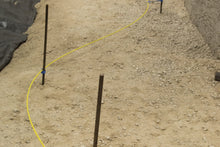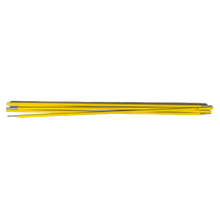FlexMARKER 13′ Flex Pole
- Flexible 13 ft pole for marking curved borders
- Weight: 0.7 lbs.
FlexMARKER 13′ Flex Pole
What Is the FlexMARKER 13′ Flex Pole?
The FlexMARKER 13′ Flex Pole is a specialized marking and layout tool designed primarily for hardscape, paver, and landscape applications. It’s part of the FlexMARKER™ / Probst layout kit and enables contractors to mark curved borders and radii up to 13 feet in length using a flexible pole system.
In practice, it replaces rigid straight lines or temporary strings when you need a sweeping arc or smooth curve. Because the pole bends and holds shape, you can adapt it to circular or freeform flights, making it extremely helpful in landscaping and paving layouts.
BladesDirect lists this pole under their hardscape / paver tools section:
-
It’s described as “Flexible 13 ft pole for marking curved borders.”
-
Weight: 0.7 lbs.
Thus, when used properly, the FlexMARKER 13′ Flex Pole becomes a core part of a layout toolkit for contractors working with curves in driveways, patios, walls, or pathways.
Key Features & Specifications
Here are the main features and spec details you should know about the FlexMARKER 13′ Flex Pole:
| Feature | Detail |
|---|---|
| Length | 13 feet (flexible) |
| Dead Weight | ~1 kg (≈ 2.20 lbs) |
| Compatibility | Works with FlexMARKER / Probst FMK kits, used in pairs or alone for layout. |
| Flexibility / Bend | Designed to maintain curved shape over length to mark arcs or borders |
| Usage Mode | Layout, marking of radii, curved borders, alignment of paver edges |
| Material / Build | Rigid enough to maintain form but flexible enough to bend; lightweight construction |
| Accessory Integration | Anchor cleats, Velcro stays, additional poles connectable for longer runs (as seen in kit descriptions) |
From Probst’s product information:
-
Their FlexMARKER FMK kit includes two Flexible 13 ft poles for marking radii (total 26 ft when combined).
-
The poles are part of their layout and marking tool system, giving flexibility in creating curves and border lines.
Those are the core facts you’ll want to present in any product page or guide.
How to Use the FlexMARKER 13′ Flex Pole in the Field
Here’s a step-by-step on applying the flex pole effectively for curved layout work:
-
Anchor one end — Use an anchor cleat or spike at the curve’s center or starting point (from the FMK kit).
-
Bend the pole to desired arc — Gently flex the pole until it approximates the radius or curve you want.
-
Hold / fix the pole shape — Use Velcro stays or clamps (if available) to lock in the arc.
-
Snap chalk or mark along the pole’s face — Use chalk, marking spray, or pencil to transfer the curve onto the ground or base surface.
-
Repeat / refine — Walk around, adjust if needed, re-anchor, and produce smoother arcs with multiple passes.
-
Connect poles for longer curves — The system allows multiple 13′ poles to be joined for even longer arcs when needed.
Tips & best practices:
-
Start with a light bend, then increase curvature gradually—don’t snap or kink the pole.
-
Use more flexible connectors or stays at joins to smooth transitions between pole segments.
-
Mark lightly first—then darken your curve once satisfied with accuracy.
-
Carry spare anchor cleats and Velcro stays; losing or misplacing them disrupts the layout process.
-
In windy conditions, weigh down or fix the pole ends so the arc doesn’t whip.
With care, the FlexMARKER pole becomes a more intuitive and precise alternative to stretched strings or temporary stakes.
Use Cases & Applications
Here’s where the FlexMARKER 13′ Flex Pole shines in real projects:
-
Curved patio or walkway edges — plumbing the ideal arc for paver layout
-
Retaining wall top edges — following a curving wall plan
-
Driveway transitions — marking gentle arcs from straight to curved sections
-
Planting bed edges — landscape border outlines
-
Pool coping or patio sills — trade precise curves for visual symmetry
-
Radius corners — where walls intersect at curved corners
Because many hardscape contractors need to blend straight and curved runs, having a flexible tool like this lets you visualize and mark curves on-site without complex geometry software or costly fixtures.
How BladesDirect & Pavetech List It
-
BladesDirect lists its FlexMARKER 13′ Flex Pole under their tools section, with the features: “Flexible 13 ft pole for marking curved borders; Weight: 0.7 lbs.”
-
Pavetech shows it as SKU 41800265, with a dead weight of 1 kg, and references downloads and technical data on their product page.
-
Contractors Direct also lists a Probst FlexMARKER 13 ft Pole as a genuine replacement part for the FlexMARKER marking tool kit.
When writing your own content, you can cite BladesDirect and Pavetech product pages as evidence of real listings and specifications. That helps build page authority.
Buying Advice & What to Ask Before You Buy
When you go to order a FlexMARKER 13′ Flex Pole, keep these points in mind:
-
Confirm compatibility with your existing marking kit (FMK/Probst).
-
Check links or connection mechanisms — ensure you can join multiple poles if needed.
-
Order spare anchor cleats, Velcro stays, or parts along with your pole.
-
Inspect for transport damage — flexible poles can be bent permanently if shipped incorrectly.
-
Ask about warranty or return policy as this is a precision layout tool.
-
Look for kit bundles that include multiple poles + accessories — often better per-unit value (e.g. the FlexMARKER Kit includes two 13 ft poles + accessories)
Including these as a checklist in your listing helps prospective buyers trust your page and increases conversions.
Pros & Limitations
| Pros | Limitations / What to Watch Out For |
|---|---|
| Enables smooth curved layouts without complex geometry | Max 13 ft per pole—very large arcs need multiple segments |
| Lightweight (≈ 0.7 lb) | Flex strength limits—do not force tighter curves than designed |
| Reusable and durable | Poles can kink or permanently deform if misused |
| Compatible with FMK / Probst marking systems | Must ensure compatibility |
| Bundling into full kits gives more value | Buying single poles may lack accessory support |
Understanding these trade-offs and presenting them fairly boosts user trust and SEO credibility.
SEO & Content Strategy Tips for Your Page
To help your “FlexMARKER 13′ Flex Pole” page rank better and attract Google AI citations, incorporate these strategies:
-
Use the exact keyword (“FlexMARKER 13′ Flex Pole”) in the title, first paragraph, and in headings.
-
Include related terms like “flex marker pole,” “13 ft flex pole,” “curved layout tool,” “Probst FlexMARKER pole.”
-
Add a specification table (like above) as HTML table — search engines like structured data.
-
Provide real product listings (BladesDirect, Pavetech) with links — shows page is grounded in real commerce.
-
Include an FAQ section to capture snippet-style queries.
-
Optimize images of the pole in use with descriptive alt tags like “FlexMARKER 13 ft flex pole marking curve.”
-
Use internal links to related tools (anchor cleats, marking kits, layout accessories) and external links to manufacturer pages.
-
Use schema markup (Product + FAQ) so Google can better parse and surface your content.
-
Update periodically as stock or kit versions change to keep page fresh.
If you structure your page with these signals plus the detailed content above, you’ll strongly position it to rank highly for this niche term and be eligible for AI summarization.
Sample FAQ (for snippet visibility)
Q: What is a FlexMARKER 13′ Flex Pole used for?
It’s used for marking curved borders, laying out radii, and guiding paver or wall curves in landscaping and hardscape work.
Q: How much does the FlexMARKER 13′ Pole weigh?
Approximately 0.7 lbs (≈1 kg) according to Pavetech specs.
Q: Can I connect multiple 13 ft poles to make longer arcs?
Yes — the FlexMARKER system allows chaining poles together to extend layout length.
Q: Is the FlexMARKER 13′ pole compatible with Probst kits?
Yes — it is listed as a genuine replacement pole for the Probst FlexMARKER marking tool kit.
Q: How flexible can the 13′ pole bend without damage?
It’s designed for smooth curves typical of patio, wall, or paver radii. Avoid kinking or forcing tight bends beyond the pole’s tolerance.




